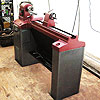I'm wondering if any Creekers could provide input on my plan for a slab top workbench I'm planning to build. I had a large silver maple cut down last year and the crew saved me a couple logs. One is 6' the other 5' and both are about 16" in diameter.
There are two main issues I'm concerned with. One is that I didn't split the logs and I don't know how hard it's going to be when I'm ready to start working on them after they're mostly dried out. I left them in the yard for most of last year and moved them in the garage for winter but they were already noticeably lighter. The other issue is that this was a big tree with the main trunk 4.5' in diameter. These logs come from branches and I don't know how close to vertical they were on the tree. Am I going to have a lot of issues with reaction wood moving around on me when it comes time to slab them up and flatten them? Will a thicker slab help minimize this problem? I'm aiming for 4" for right now.
My plan for the bench design is to have a top with a tool tray (yes I can keep it clean) in the middle of two different size solid slabs. One will be as wide as I get it to form a primary work surface at least 13" wide. The other slab will be sized to keep the tray and itself around 11" wide so the total width comes out to somewhere around 24". I'm going to take advantage of the tray to handle the expansion of the slabs. My idea is to anchor their outside corners into breadboard ends and allow the slabs to only expand inward toward tray opening on floating tongue and groove joints. Because of the tray and independent slabs I'm going to need more substructure than a Roubo style bench. With the slabs floating in this way I hope to be able to keep their faces flush to the legs despite different expansion characteristics of the top and the base. Are there any potential snafus with this arrangement that come to mind? Am I going to have some severe cupping issues with slabs this wide coming from a relatively small log?




 Reply With Quote
Reply With Quote

 . All you lose is time since the wood didn't cost you anything.
. All you lose is time since the wood didn't cost you anything.


